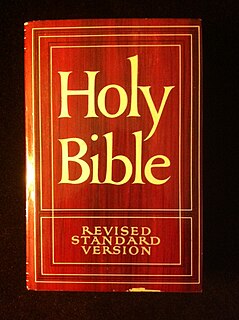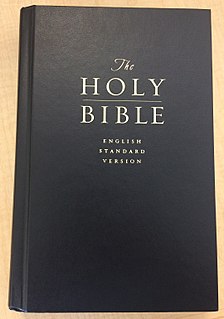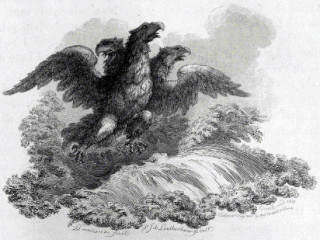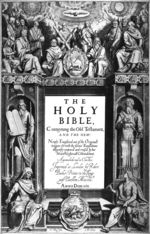
The Bible is a collection of religious texts or scriptures sacred to Christians, Jews, Samaritans, Rastafari and others. It appears in the form of an anthology, a compilation of texts of a variety of forms that are all linked by the belief that they are collectively revelations of God. These texts include theologically-focused historical accounts, hymns, prayers, proverbs, parables, didactic letters, erotica, poetry, and prophecies. Believers also generally consider the Bible to be a product of divine inspiration.

The deuterocanonical books are books and passages considered by the Catholic Church, the Eastern Orthodox Church, the Oriental Orthodox Churches and the Assyrian Church of the East to be canonical books of the Old Testament but which are considered non-canonical by Protestant denominations. They date from the period 300 BC–AD 100 approximately. While the New Testament never quotes from or ascribes canonical authority to these books, some say there is a correspondence of thought, while others see texts from these books being paraphrased, referred or alluded to many times in the New Testament, particularly in the Pauline epistles depending in large measure on what is counted as a reference.

The Old Testament is the first part of the Christian biblical canon, which is based primarily upon the twenty-four books of the Hebrew Bible, a collection of ancient religious Hebrew writings by the Israelites believed by most Christians and religious Jews to be the sacred Word of God. The second part of Christian Bibles is the New Testament, written in the Koine Greek language.

The Greek Old Testament, or Septuagint, is the earliest extant Koine Greek translation of books from the Hebrew Bible, various biblical apocrypha, and deuterocanonical books. The first five books of the Hebrew Bible, known as the Torah or the Pentateuch, were translated in the mid-3rd century BCE; they did not survive as original-translation texts, however, except as rare fragments. The remaining books of the Greek Old Testament are presumably translations of the 2nd century BCE.

The Vulgate is a late-4th-century Latin translation of the Bible. It was to become the Catholic Church's officially promulgated Latin version of the Bible during the 16th century and is still used in the Latin Church alongside the Hebrew and Greek sources.

The World English Bible (WEB) is an English translation of the Bible published in 2000. It is an updated revision of the American Standard Version (1901). The World English Bible was created by volunteers using the American Standard Version as the base text as part of the ebible.org project through Rainbow Missions, Inc., a Colorado nonprofit corporation. The World English Bible is one of the few public domain, twenty-first century English translations of the entire Bible, and it is freely distributed to the public using electronic formats.

The Revised Standard Version (RSV) is an English translation of the Bible published in 1952 by the Division of Christian Education of the National Council of the Churches of Christ in the USA. This translation itself is a revision of the American Standard Version (ASV) of 1901, and was intended to be a readable and literally accurate modern English translation which aimed to "preserve all that is best in the English Bible as it has been known and used through the centuries" and "to put the message of the Bible in simple, enduring words that are worthy to stand in the great Tyndale-King James tradition."

The New Revised Standard Version (NRSV) is an English translation of the Bible published in 1989 by the National Council of Churches. It is a revision of the Revised Standard Version, which was itself an update of the American Standard Version. The NRSV was intended as a translation to serve devotional, liturgical and scholarly needs of the broadest possible range of religious adherents. The full translation includes the books of the standard Protestant canon as well as the Deuterocanonical books traditionally included in the canons of Roman Catholicism and Eastern Orthodox Christianity.

The English Standard Version (ESV) is an English translation of the Bible. It was first published in 2001 by Crossway. The ESV is based on the 1971 edition of the Revised Standard Version (RSV) text.

The Revised Standard Version Catholic Edition is an English translation of the Bible first published in 1966. In 1965, the Catholic Biblical Association adapted, under the editorship of Bernard Orchard OSB and Reginald C. Fuller, the Revised Standard Version (RSV) for Catholic use. It contains the deuterocanonical books of the Old Testament placed in the traditional order of the Vulgate. The editors' stated aim for the RSV Catholic Edition was "to make the minimum number of alterations, and to change only what seemed absolutely necessary in the light of Catholic tradition."

2 Esdras is the name of an apocalyptic book in many English versions of the Bible. Its authorship is ascribed to Ezra, a scribe and priest of the 5th century BCE, although modern scholarship places its composition between 70 and 218 CE. It is reckoned among the apocrypha by Roman Catholics, Protestants, and most Eastern Orthodox Christians. 2 Esdras was excluded by Jerome from his Vulgate version of the Old Testament, but from the 9th century onwards the Latin text is sporadically found as an appendix to the Vulgate, inclusion becoming more general after the 13th century.
The Christian Community Bible is a translation of the Christian Bible in the English language originally produced in the Philippines.

The Oxford Annotated Bible (OAB), also known as the New Oxford Annotated Bible (NOAB), is a study Bible published by the Oxford University Press. The notes and the study material feature in-depth academic research from nondenominational perspectives, specifically secular perspectives for "Bible-as-literature" with a focus on the most recent advances in historical criticism and related disciplines, with contributors from mainline Protestant, Roman Catholic, Jewish, and nonreligious interpretative traditions.
These are the books of the Vulgate along with the names and numbers given them in the Douay–Rheims Bible and King James Bible. There are 76 books in the Clementine edition of the Latin Vulgate, 46 in the Old Testament, 27 in the New Testament, and 3 in the Apocrypha.

The biblical apocrypha denotes the collection of apocryphal ancient books thought to have been written some time between 200 BC and 400 AD. Most Christian Churches include some or all of the same texts within the body of their version of the Old Testament.

The Old Testament is the first section of the two-part Christian biblical canon; the second section is the New Testament. The Old Testament includes the books of the Hebrew Bible (Tanakh) or protocanon, and in various Christian denominations also includes deuterocanonical books. Orthodox Christians, Catholics and Protestants use different canons, which differ with respect to the texts that are included in the Old Testament.

A Catholic Bible is a Christian Bible that includes the whole 73-book canon recognized by the Catholic Church, including the deuterocanonical books.

A biblical canon or canon of scripture is a set of texts which a particular Jewish or Christian religious community regards as authoritative scripture. The English word canon comes from the Greek κανών, meaning "rule" or "measuring stick". Christians were the first to use the term in reference to scripture, but Eugene Ulrich regards the notion as Jewish.

A Protestant Bible is a Christian Bible whose translation or revision was produced by Protestants. Such Bibles comprise 39 books of the Old Testament and 27 books of the New Testament for a total of 66 books. Some Protestants use Bibles which also include 14 additional books in a section known as the Apocrypha bringing the total to 80 books. This is often contrasted with the 73 books of the Catholic Bible, which includes seven deuterocanonical books as a part of the Old Testament. The division between protocanonical and deuterocanonical books is not accepted by all Protestants who simply view books as being canonical or not and therefore classify books found in the deuterocanon, along with other books, as part of the Apocrypha.

The New American Bible Revised Edition (NABRE) is an English-language, Catholic translation of the Bible, the first major update in 20 years to the New American Bible (NAB), which was translated by members of the Catholic Biblical Association and originally published in 1970. Released on March 9, 2011, the NABRE consists of the 1986 revision of the NAB New Testament with a fully revised Old Testament approved by the United States Conference of Catholic Bishops in 2010.














